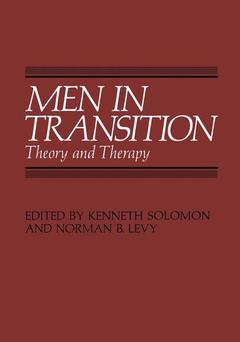Men in Transition, Softcover reprint of the original 1st ed. 1982 Theory and Therapy
Langue : Anglais
Coordonnateur : Solomon Kenneth

Every year the few hundred members of the Committees, Task Forces, and Councils of the American Psychiatric Association meet in Washington, D.C. to conduct their business. They deliberate on a wide variety of issues encompassed in the activities of each group. The psychiatrists constituting this mixed and somewhat elite group include some of the better-known and promising people in the profession, which makes the plenary session and cocktail party good occasions to meet old friends and to make new ones. Several years ago one of us (N.B.L.) attended this gathering as a member of a soon-to-be defunct group, the Committee Liaison with the American College of Physicians, and met Ann Chappell, a member of the Task Force on Women. We were soon joined by Richard Grant. Ann impressed us with the work her group was doing on issues surrounding the Women's Movement as it relates to patients and the changing roles of the early 1970s. She was struck by the fact that although some women had been very active in this endeavor, nobody in Ameri can psychiatry was addressing issues which are arising in men as a result of the changing roles of women in society. Dick and Norm were moved by what she said and decided that they would make an effort to gather together people interested in the issue of the changing roles of males in society at the oncoming meeting of the American Psychiatric Association.
1 • Gender-Role Conflict and Strain in Men’s Lives: Implications for Psychiatrists, Psychologists, and Other Human-Service Providers.- Gender-Role Strain and Conflict in the 1970s: Effects on Men.- Recent Literature on Men: Common Themes of Gender-Role Strain and Conflict.- Gender- and Sex-Role Terminology.- Gender-Role Conflict and Strain Explained.- Gender-Role Socialization.- Subordination of Feminine Values: Outcomes of the Masculine Mystique and Value System.- Fear of Femininity: The Cradle of Gender-Role Conflicts and Strain.- Comment and Criticism on the Fear of Femininity.- Patterns of Gender-Role Conflict and Strain Identified.- Patterns of Gender-Role Conflict and Strain: A Critique…..- Implications of Gender-Role Conflict for Psychiatrists, Psychologists, and Other Human-Service Providers….- Some Final Thoughts and Personal Disclosures.- Acknowledgments.- References.- 2 • The Masculine Gender Role: Description.- Historical Overview.- Definitions.- The Development of Gender Role.- Dimensions of the Masculine Role.- The Effects of the Masculine Role.- Conclusion.- References.....- 3 • Psychoanalytic-Developmental Theory and the Development of Male Gender Identity: A Review.- Sigmund Freud.- Carl Gustav Jung.- Harry Stack Sullivan.- Margaret Mahler.- Erik Erikson.- Daniel Levinson and George Vaillant.- John Money and Robert Stoller.- Recapitulation.- Acknowledgment.- References.- 4 • Androgyny.- Androgyny: An Old Idea in a New Dress.- Gender-Identity Formation.- Sex-Role Acquisition.- Cognitive Development Theory: The Mind as Message…..- Sex-Role Acquisition and the Possibility of Androgyny.- Measuring Androgyny.- Sugar and Spice and Puppy-Dog Tails: The Components of.- Masculinity and Femininity.- High Masculinity: Agency.- Androgyny: Boon or Bane?.- Alternative Futures.- References.- 5 • Male Inexpressiveness: Psychological and Social Aspects.- Evidence of Expressive Differences between Genders.- Explanations of Male Inexpressiveness.- Consequences of Male Inexpressiveness..- Strategies For Change.- Implications of Increased Male Expressiveness.- References.- 6 • The Effect of Changing Sex Roles on Male Homosexuals.- Clarification of Terminology.- The Literature on Male Homosexuality.- Gay Male Sexuality..- Some Myths Destroyed by the Research.- Changes in Gay Male Sexuality..- The Discovery of Homophobia.- Changes in Lifestyle and Relationships.- The Gay Male.- Changing Attitudes.- Conclusion.- References.- 7 • Sexual Functioning in Relation to the Changing Roles of Men.- References.- 8 • Dual Careers and Changing Male Roles.- The Current Situation.- Some Women Can.- What Do Women Want?.- ... And Men?..- Struggling toward Androgyny.- The Professional Couple.- Trouble.- Can It Work Better?.- Children... And Time.- References.- 9 • The “Abandoned Husband”: When Wives Leave.- Sample.- Clinical Findings.- Discussion.- References.- 10 • Postparental Fathers in Distress.- A Time of Relief?.- Fathers Can Be Unhappy, Too.- Most Interest: Most to Lose.- Growing Male Nurturance.- Case I.- Case II.- Conclusions.- References.- 11 • The Older Man.- Characteristics of the Older Man.- Stress and Coping in the Elderly.- Special Stresses for Older Men.- Therapeutic Issues.- Conclusion.- References.- 12 • Where Have All the Heroes Gone? Another View of Changing Masculine Roles.- References.- 13 • Individual Psychotherapy and Changing Masculine Roles: Dimensions of Gender-Role Psychotherapy.- Gender-Role Psychotherapy Defined.- Indications.- Therapeutic Issues.- Technical Notes.- Special Problems.- Transference Issues.- Countertransference Issues.- Conclusion.- References.- 14 • Men’s Groups.- Historical Background of Men’s Groups.- Rationale.- Characteristics of Men’s Groups.- Types of Men’s Groups.- Outcomes.- Applications of Men’s Groups in the Mental Health Field...- Conclusion.- References.- 15 • Clinical Behavior Therapy and the Male Sex Role.- On Being a Man...- What Brings Men into Therapy?.- Behavioral Interventions.- Psychological Androgyny.- Behavior Therapy and the Larger Social System.- Summary.- Acknowledgments.- References.- 16 • Male Inexpressiveness: Behavioral Intervention.- Male Inexpressiveness.- Assessment of Expressiveness.- Expressiveness Training.- Summary.- Acknowledgments.- Appendix A: Self-Report Assessment of Expressiveness…..- Appendix B: Nonverbal Expressiveness Rating Scales.- References.- 17 • The Female Therapist in Relation to Male Roles.- Feminist Views of Psychotherapy.- The Woman Therapist’s Position.- Male Role Restrictions—Social Determinants.- The Dynamics of Male Role Socialization.- Advantages of the Female Therapist..- The Treatment Process: Phases and Dilemmas.- Conjoint Work with Male Therapists.- Summary.- References.- 18 • Epilogue.- An Invitation to the Reader.- Disparate Reactions to the Book.- A Change in Perspective.- Androgyny.- Goals of Psychotherapy.- Conclusion.- References.- 19 • Counterepilogue.- Man as He Appears to Our Authors.- What a Man Is, In and Of Himself.- Men Dealing with Other Men.- Men in Relation to Women.- Men in Relation to Their Children.- Who Wants What?.- What Do the Men Want?.- What Do Women Want of Men?.- What Do Our Authors Want?.- References.- Author Index.
Date de parution : 03-2012
Ouvrage de 504 p.
17.8x25.4 cm
Disponible chez l'éditeur (délai d'approvisionnement : 15 jours).
Prix indicatif 52,74 €
Ajouter au panierThème de Men in Transition :
Mots-clés :
coping; identity; intervention; patients; psychiatry; psychotherapy; sexuality; stress; therapy; women
© 2024 LAVOISIER S.A.S.
